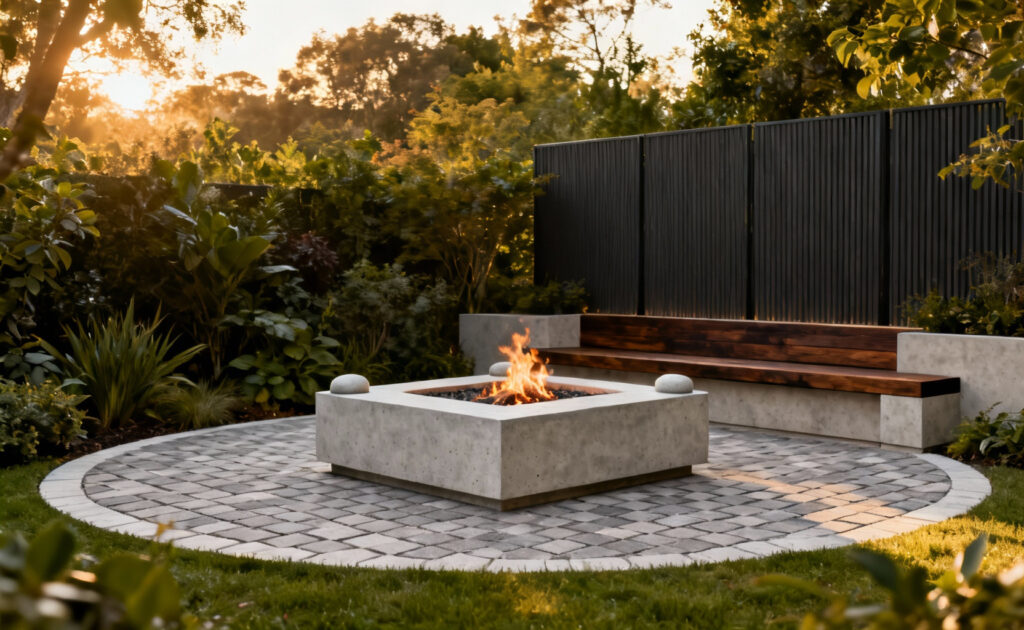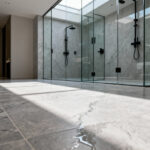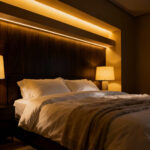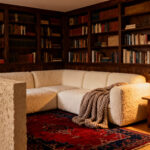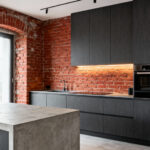I promise your backyard can become a true extension of your home—an outdoor sanctuary where the elemental draw of fire meets refined, intentional design. As a designer specializing in the science and art of materials, I’ve seen how mastering this balance separates a simple fire feature from a profoundly functional space. It’s a matter of understanding the deep narrative of your materials. After analyzing countless bespoke outdoor installations and innovations in material science, I have curated 20 transformative firepit ideas for your backyard. These aren’t fleeting trends. They are foundational investments in your property and your experience, each one creating a space that radiates visual intrigue and deep comfort.
My work in material combinations and texture layering has taught me that the story of a great firepit begins long before the flame is lit. It’s in the dialogue between rough-hewn basalt and the evolving patina of Corten steel. It’s in the subtle integration of water that creates a dynamic, sensory experience. This isn’t just about building something that holds fire; it’s about composing an atmosphere that resonates with the landscape and cultivates connection.
This guide is your blueprint, organized into four dimensions of firepit mastery. We will begin with Foundational Principles for placement and sensory layering, then delve into the Material Science behind basalt, steel, and concrete. From there, we’ll connect these ideas to broader Design Philosophies about creating gathering spaces, and finally, we will explore the Pinnacle of Bespoke Craftsmanship with advanced, custom solutions. Prepare to ignite your vision.
Foundational Principles for a Cohesive Sanctuary
Everything starts with the site. Before we can talk about stone or steel, we must understand the space itself. This section covers the essential first steps in crafting an outdoor sanctuary, from placement and form to the sensory layers of light, texture, and even aroma that bring the entire experience to life.
1. Master the Site: Strategic Placement for Ambiance and Safety
The effectiveness of any backyard firepit idea starts not with its form, but with its placement. Where you site your fire feature dictates everything—the social dynamics, the sensory journey, and critical safety. In my own design practice, I always emphasize that a firepit must be choreographed into a dance with its surroundings. This means analyzing wind patterns to keep smoke away from guests, ensuring ample clearance from flammable structures and trees, and orienting the seating to capture the best view, whether it’s of the flame or a distant horizon.
Think of it this way: are you creating an intimate, enclosed nook or an expansive, open-air theater? The answer lies in the land itself. Landscape architect Julian Vance’s ‘Ember Knoll Project’ is a perfect example. He recessed a linear concrete firepit into a sloped bluestone patio. The site’s natural grade became a tool, blocking the wind while framing a dramatic view of the ravine below. The firepit wasn’t just placed on the patio; it felt anchored by the very contours of the earth. That’s how strategic siting moves beyond mere function to become a truly transformative act.
2. Embrace Form: Sculptural Fire Pits as Artistic Focal Points
Once placed, a firepit becomes a powerful opportunity for sculptural expression. It is far more than a container for a flame; its very form dictates the aesthetic and emotional resonance of your entire outdoor space. I often design not just for warmth, but for wonder. When a firepit is conceived with sculptural intent, it elevates itself from utility to art, becoming a commanding presence that grounds the whole composition. This philosophy demands materials with integrity—the monolithic heft of polished concrete, the rustic patina of Corten steel, or the timeless solidity of carved granite—shaped into a deliberate form.
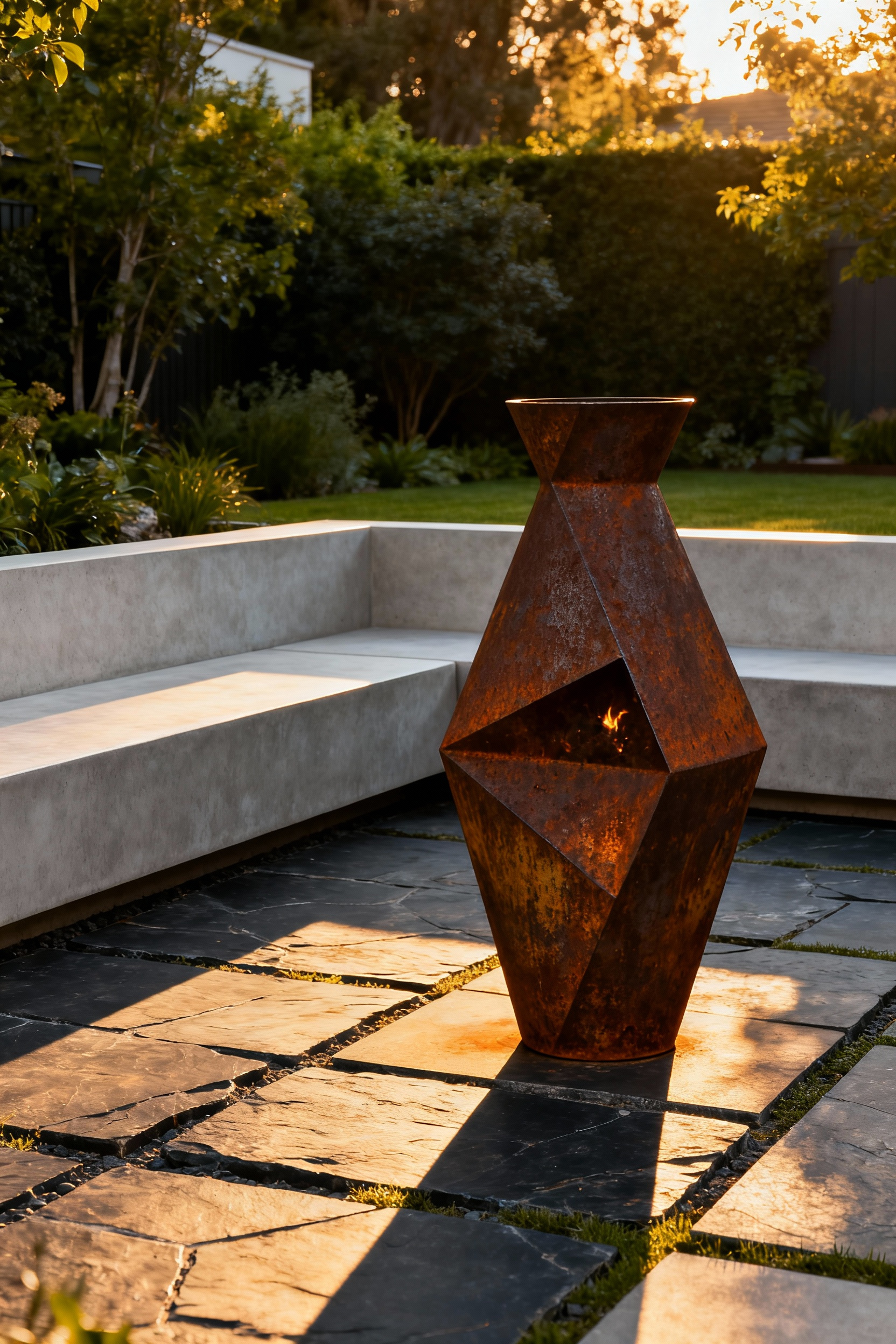
The ‘Orion’ firebowl by designer Elara Vance, cast from a unique basalt-aggregate blend, is a masterclass in this approach. Its perfectly spherical shape, oversized and clean, creates a dramatic counterpoint to the linear architecture of the courtyard it inhabits. It has a primordial feel, as if it were a natural outcropping that had always belonged there. The piece functions as significant outdoor art. When you begin to see the firepit as a sculptural entity, it changes everything. It becomes a beautiful object in its own right, resonating year-round, fire or no fire.
3. Illuminate Proximity: Integrating Light for a Layered Evening Glow
The real magic of a firepit awakens after sunset, but its full potential is only unlocked with a thoughtful layering of ancillary lighting. Relying solely on the fire’s flicker is poetic, but it leaves surrounding spaces undefined and dim. Effective outdoor lighting doesn’t compete with the fire; it builds a harmonious visual tapestry around it, expanding its inviting glow and enhancing the sense of depth. This involves deploying various light sources—subtle path lights for safety, concealed uplights accenting a beautiful tree, or even low-level string lights creating a festive canopy.
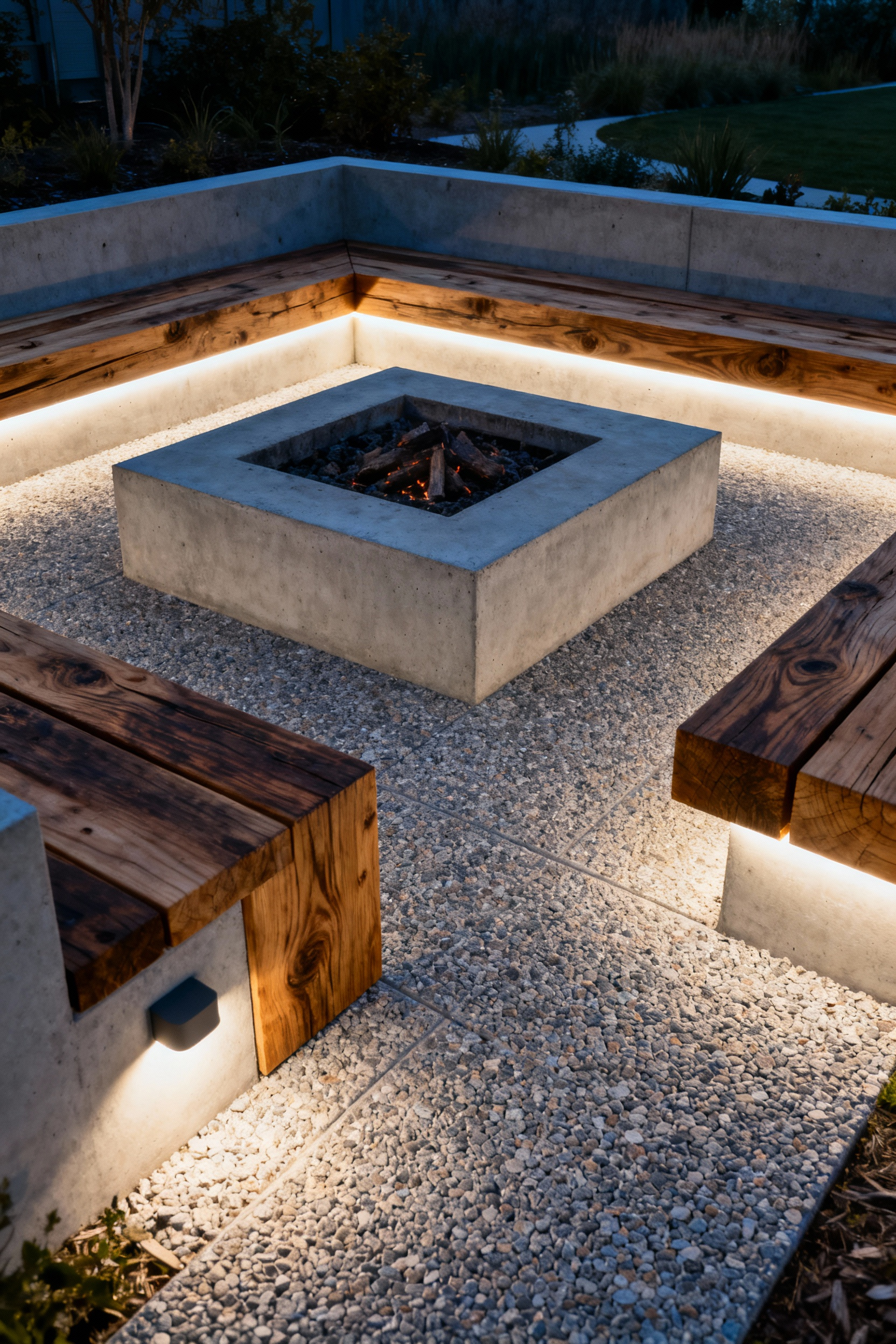
Dr. Anya Sharma of LuxTerra Lighting Design perfectly executed this in her ‘Solstice Sanctuary’ project. She tucked warm LED strip lights under the capstone of a circular firepit, creating a halo effect. She then paired this with shielded bollard lights along the patio’s perimeter. The result was a series of connected ‘light rooms’—a soft embrace around the fire, a slightly brighter zone for dining, and subtly lit pathways connecting them all. What’s critical is that the color temperature of every fixture was carefully selected to harmonize with the golden hues of the flame. It’s this careful orchestration that turns a simple patio into an exquisite and captivating evening environment.
4. Layer Texture: Harmonizing Hardscapes for Sensory Cohesion
The visual and tactile qualities of the surfaces immediately surrounding a firepit are crucial for creating a sense of place. The materials must speak to each other. A firepit is never an isolated object; it is a vital part of a broader composition. The hardscape that cradles it must engage in a dialogue, whether through harmonious continuity or thoughtful contrast. Think of the smooth, cool feel of honed concrete pavers against the rugged, evolving surface of a Corten steel firepit, or the soft crunch of decomposed granite underfoot around a rustic stone fire bowl.
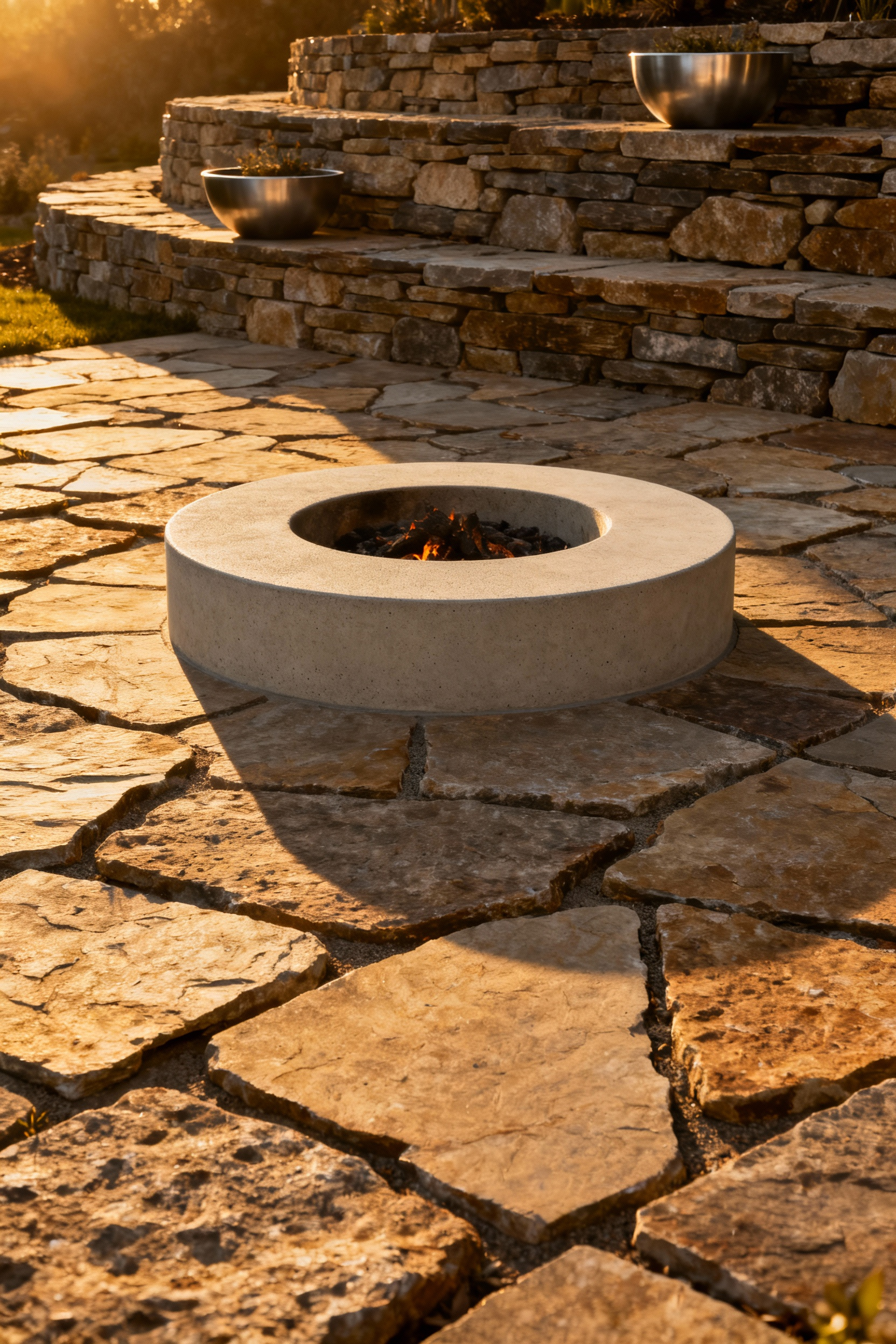
A project I always remember is by landscape architect Kai Nakamura, who designed a linear firepit clad in rough-hewn flagstone. He surrounded it with expansive concrete slabs finished with an exposed aggregate, separating them with slender bands of dark river pebbles. He intended to celebrate the intrinsic nature of each material. The raw, primal quality of the flagstone was deliberately contrasted with the refined industrial elegance of the concrete, while the pebbles introduced a third, delicate tactile dimension. This layering doesn’t just look good; it enriches your physical interaction with the space, appealing to both sight and touch.
5. The Alchemical Blend: Selecting Fuel for Sensory Impact
The allure of a flickering flame is a multi-sensory spectacle, and the fuel you choose plays a pivotal role. The type of wood you burn is as much a design choice as the stone you build with, dictating the visual cadence, the crackle, and the lingering aroma. Each wood has its own ‘terroir’—a unique density and resin that determines its character. I guide my clients to think of wood as a tool for setting a mood. Seasoned oak provides a slow, contemplative burn with a robust aroma. Applewood offers a bright crackle and a sweet scent perfect for festive, culinary-focused occasions. Cedar brings drama with a vibrant visual and an almost incense-like fragrance.
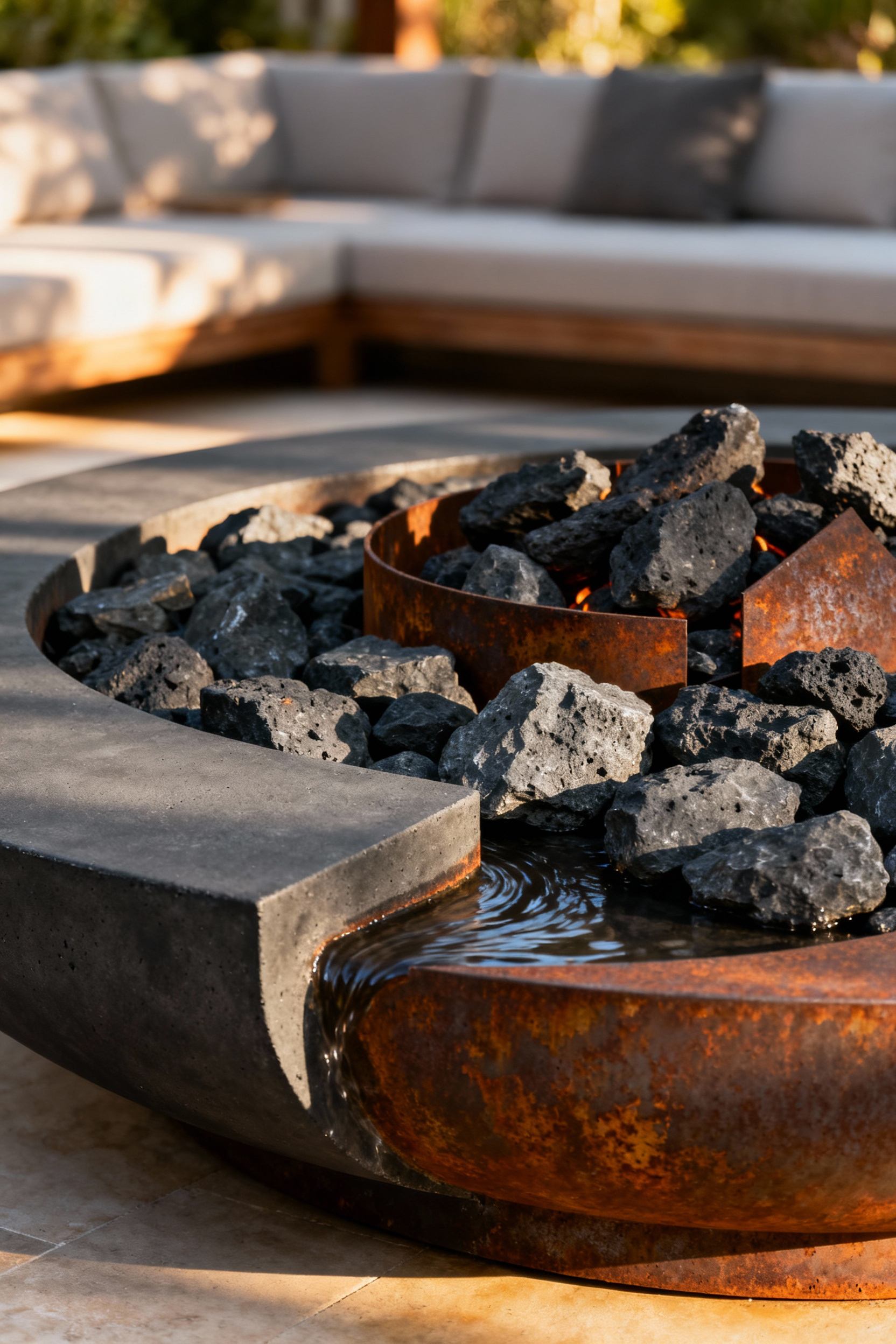
Of course, aesthetics must be balanced with combustion science. The most beautiful flame quickly loses its charm if it’s smoky or inefficient. As engineer Julian Thorne of Pyre Systems Innovations points out, green, unseasoned wood creates a cooler, smokier fire because so much energy is wasted burning off excess moisture. This not only masks the wood’s inherent aroma but is a safety concern due to creosote buildup. The best sensory impact—both visual and olfactory—is inextricably linked to practical considerations. A clean, efficient burn from properly seasoned hardwood enhances both the flame’s beauty and its fragrant purity.
Material Science and Lasting Aesthetics
Great design is rooted in an honest understanding of materials. It’s about knowing how a material will perform under heat, how it will weather the elements, and how its character will deepen over time. This section explores the science behind some of the most enduring and beautiful choices for modern firepits.
6. Basalt Stone: Volcanic Elegance and Thermal Resilience
In the search for materials that offer both aesthetic impact and unwavering durability, we often find ourselves returning to nature’s most elemental creations. Basalt is preeminent among them. Born from cooled lava, this igneous rock offers an unparalleled combination of elegance and thermal resilience. What I love about basalt is its almost primeval energy. Its dark, uniform grey palette provides a superb, quiet backdrop that allows the dancing flames to become the true focal point.

Its geological genesis is the key to its performance. Formed from rapidly cooled lava, its fine-grained structure is exceptionally dense, making it resistant to the thermal shock that can crack lesser stones. Dr. Aris Thorne, a materials scientist specializing in stone, explains that basalt has a low thermal expansion coefficient, meaning it expands and contracts minimally when heated. This drastically reduces stress on the material. From a longevity standpoint, this means minimal maintenance and incredible structural integrity over decades. It’s an investment in a piece of enduring, elemental art.
7. Corten Steel: A Living Patina That Evolves Over Time
Few materials embody the concept of a ‘living aesthetic’ as profoundly as Corten steel. It’s designed to rust. But this isn’t destructive corrosion; it’s a controlled oxidation process that forms a dense, tightly bonded patina—a beautiful, living finish that acts as a protective shield, sealing the core steel from further atmospheric attack. Its beauty lies in its intentional journey. Exposed to the elements, it develops a rich, earthy palette of russets, oranges, and deep browns. This dynamic skin tells a story of time and exposure.
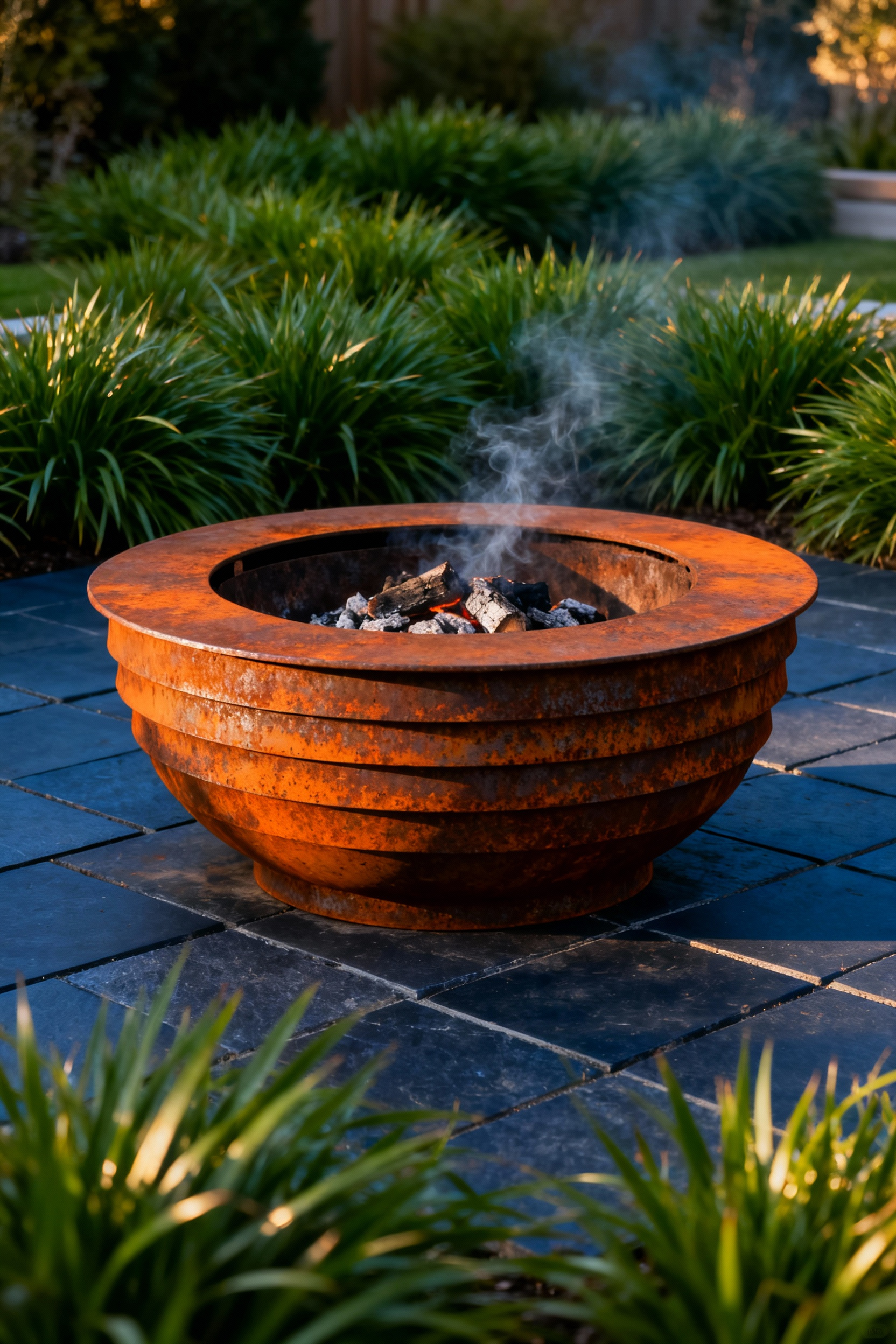
Designer Isabella Rossi of Terra Forms Studios calls Corten a “co-creator.” She designed a sprawling, serpentine Corten fire bench in Palm Springs, where the material’s ability to echo the landscape’s natural tones and endure extreme temperatures was essential. What’s more, its low maintenance requirements free you from constant upkeep. To integrate Corten steel into your backyard is to embrace a piece of living art, a dynamic element that engages with its environment. Its beauty only deepens with every passing season.
8. Architectural Concrete: Brutalist Form, Modernist Statements
Architectural concrete has evolved far beyond its utilitarian roots into a sophisticated design medium capable of bold, modernist statements with unrivaled durability. I’ve learned in my own professional experience that concrete is the ultimate chameleon in the hands of a skilled artisan. It allows for massive, monolithic forms that convey strength and permanence, yet its surface can be anything from perfectly smooth and polished to finely textured with exposed aggregate. Its versatility allows for bespoke creations that feel like an extension of the home’s architecture.
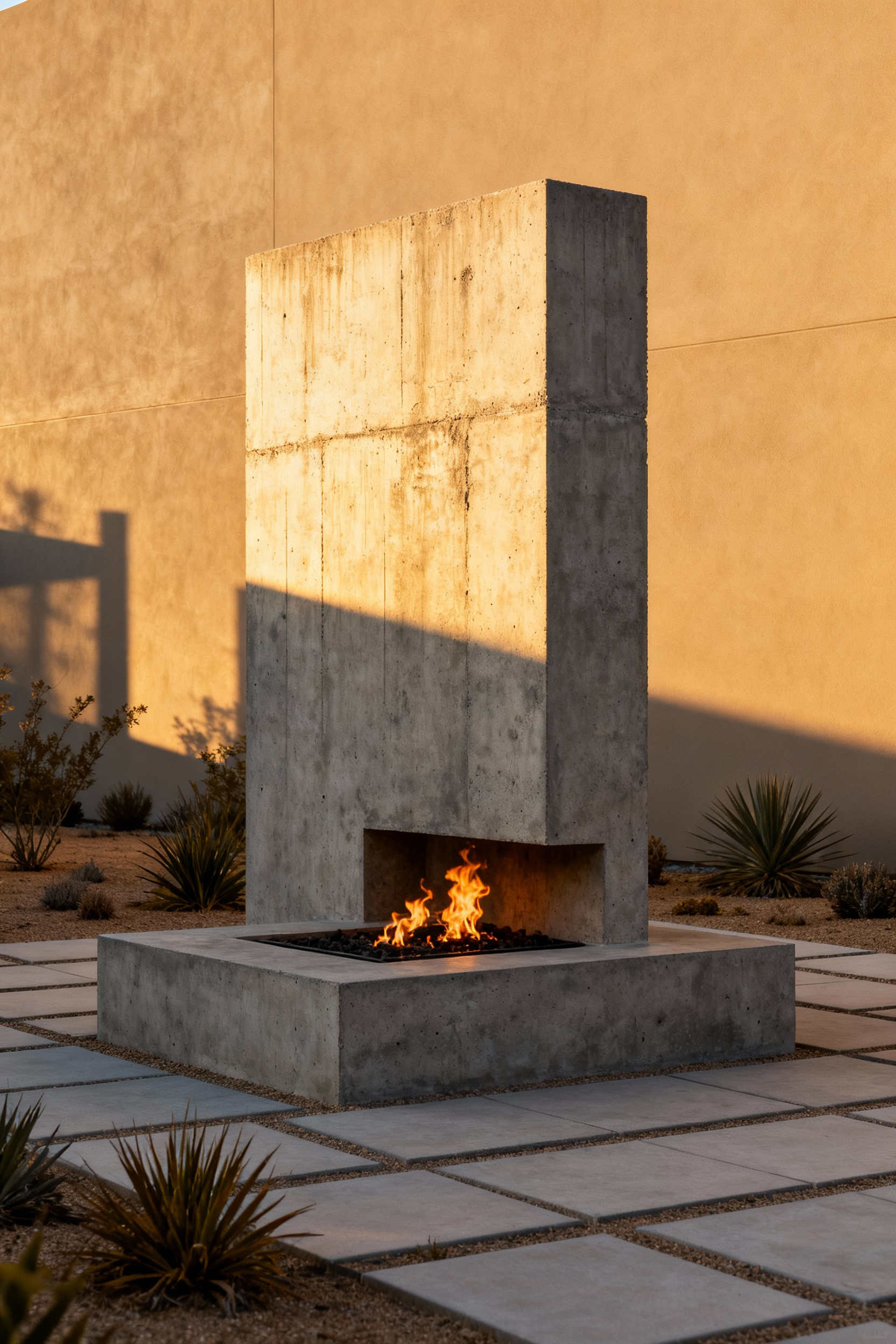
For firepits, properly specified concrete is exceptionally resilient. Maria Rodriguez, a master artisan, explains that the secret is in a high-strength, low-permeability mix using specific admixtures and reinforcement to manage thermal expansion and prevent cracking. When done right, these firepits can last for generations. The sheer thermal mass of concrete also ensures excellent heat retention. It’s an affirmation of a design philosophy that values robust construction, modernist aesthetics, and an inherent timelessness.
9. Advanced Interior Liners: Enhancing Efficiency with Ceramic Composites
While the exterior material captures our immediate attention, the true hero of an enduring firepit often lies unseen within: the interior liner. I’ve seen too many beautiful exteriors fail because of poor internal heat management. The liner’s job is not just containment, but mitigating the intense thermal load on the primary structure. Without an effective liner, repeated heating and cooling cycles will eventually cause cracks, spalling, and compromise the entire structure.
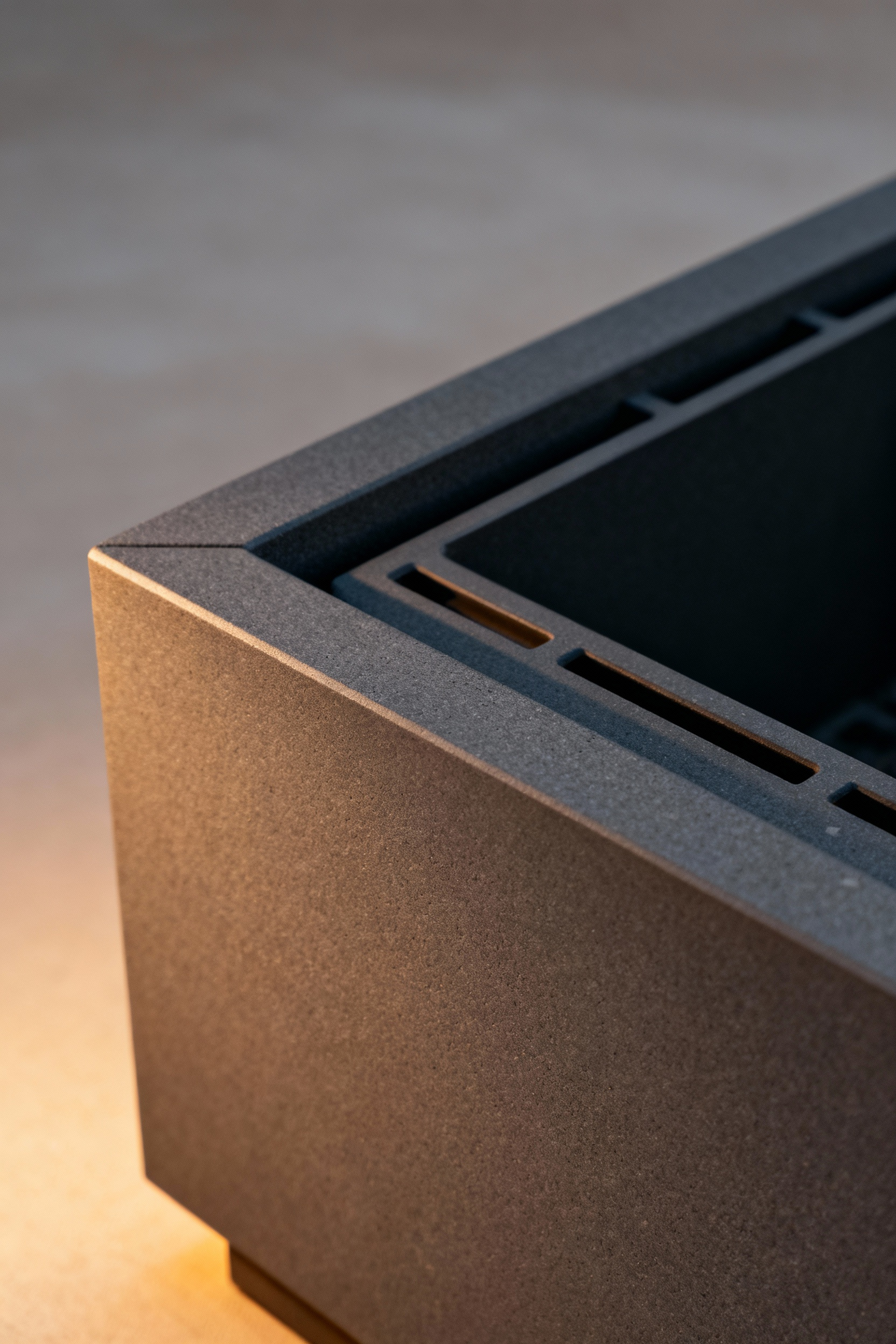
Advanced ceramic-fiber reinforced composites are a major leap forward. Unlike traditional refractory concrete, which is heavy and can crack, these composites offer superior insulation and a much lower thermal mass. This means they heat up rapidly and reflect heat efficiently back into the flame, increasing burn efficiency and creating a better fire. More importantly, they protect the expensive outer materials you’ve chosen, safeguarding them against destructive heat transfer. It’s a strategic choice that demonstrates a holistic approach to design, where invisible performance is given equal weight to visible aesthetics.
10. Bespoke Benches: Integrated Seating for Material Cohesion
A firepit is rarely a standalone feature; it’s the heart of a social space. Integrating bespoke seating is a pivotal design decision that transforms a simple warmth source into a sophisticated outdoor lounge. The bench becomes an architectural extension of the firepit itself, creating a profound material dialogue that grounds the entire arrangement. Anya Sharma of Solstice Designs masterfully executed this in Malibu, where cast-in-place concrete benches flow seamlessly from the firepit’s basalt core, defining a convivial gathering space with a unified material language.
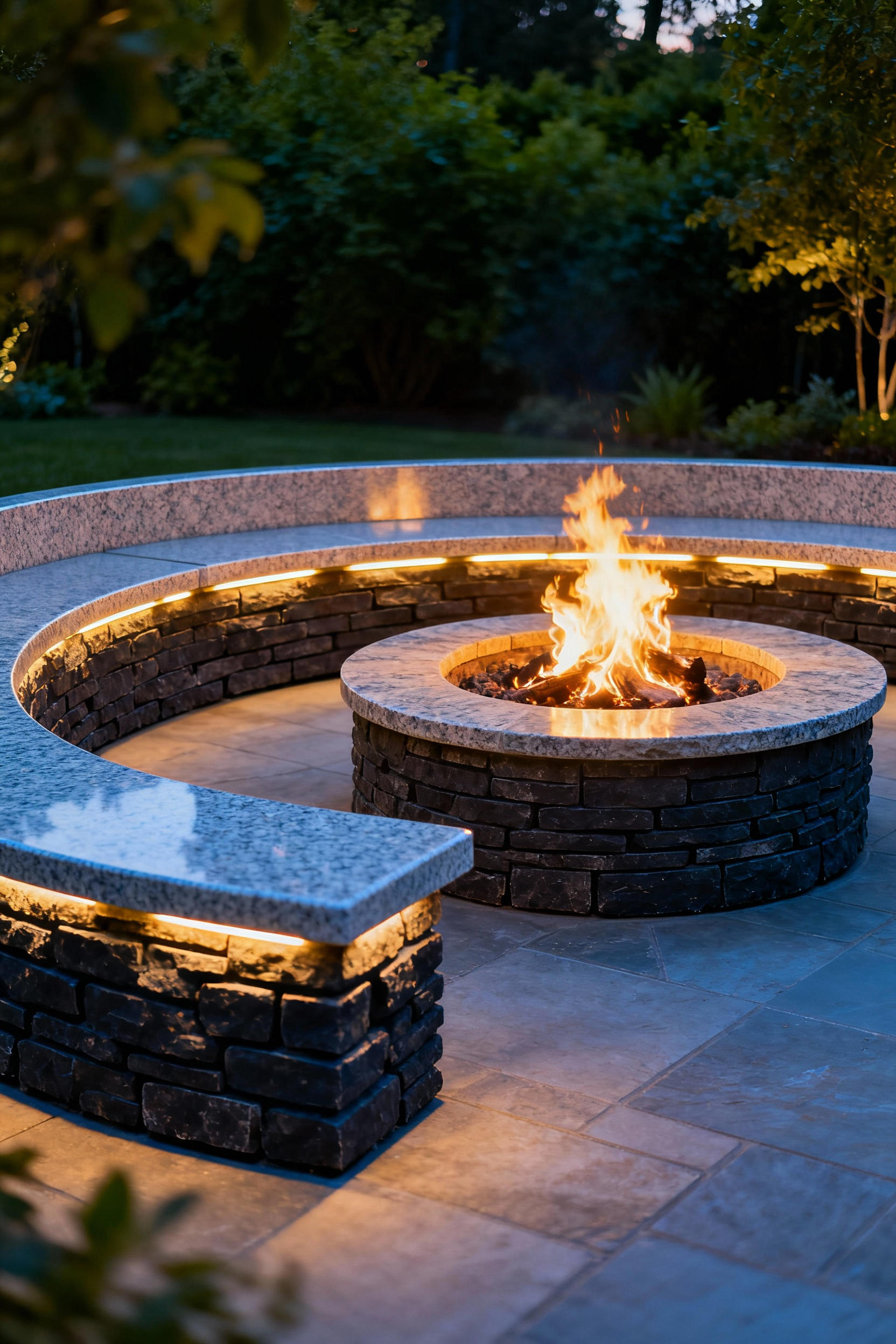
From a material science perspective, this integration demands resilience. Dr. Leo Vance, a specialist in outdoor materials, points out that you must consider how different materials will perform together. Corten steel bases might be paired with sustainably sourced Ipe or thermally modified ash for seating surfaces. The key is understanding their individual expansion rates and how they react to heat, UV exposure, and moisture. Meticulous engineering ensures these elements work in synergy, creating a comfortable, safe, and enduring social theater around the flame.
Integrating Fire into the Outdoor Narrative
A firepit is more than an object; it is the heart of an outdoor domain. This section explores the philosophies that transform a backyard amenity into an eloquent expression of how you live. It’s about movement, adaptability, sustainability, and achieving a sense of perfect, proportional harmony.
11. Cultivate the Gathering Space: Designing for Circular Flow
The magnetism of fire naturally draws people together. The best firepit designs harness this instinct by choreographing movement and sightlines to foster connection. I’ve always found that a circular layout creates the most democratic arrangement. It ensures every guest feels equally centered and connected to both the fire and each other, eliminating the hierarchical seating of a linear sofa. A circle symbolically suggests inclusivity and equality.
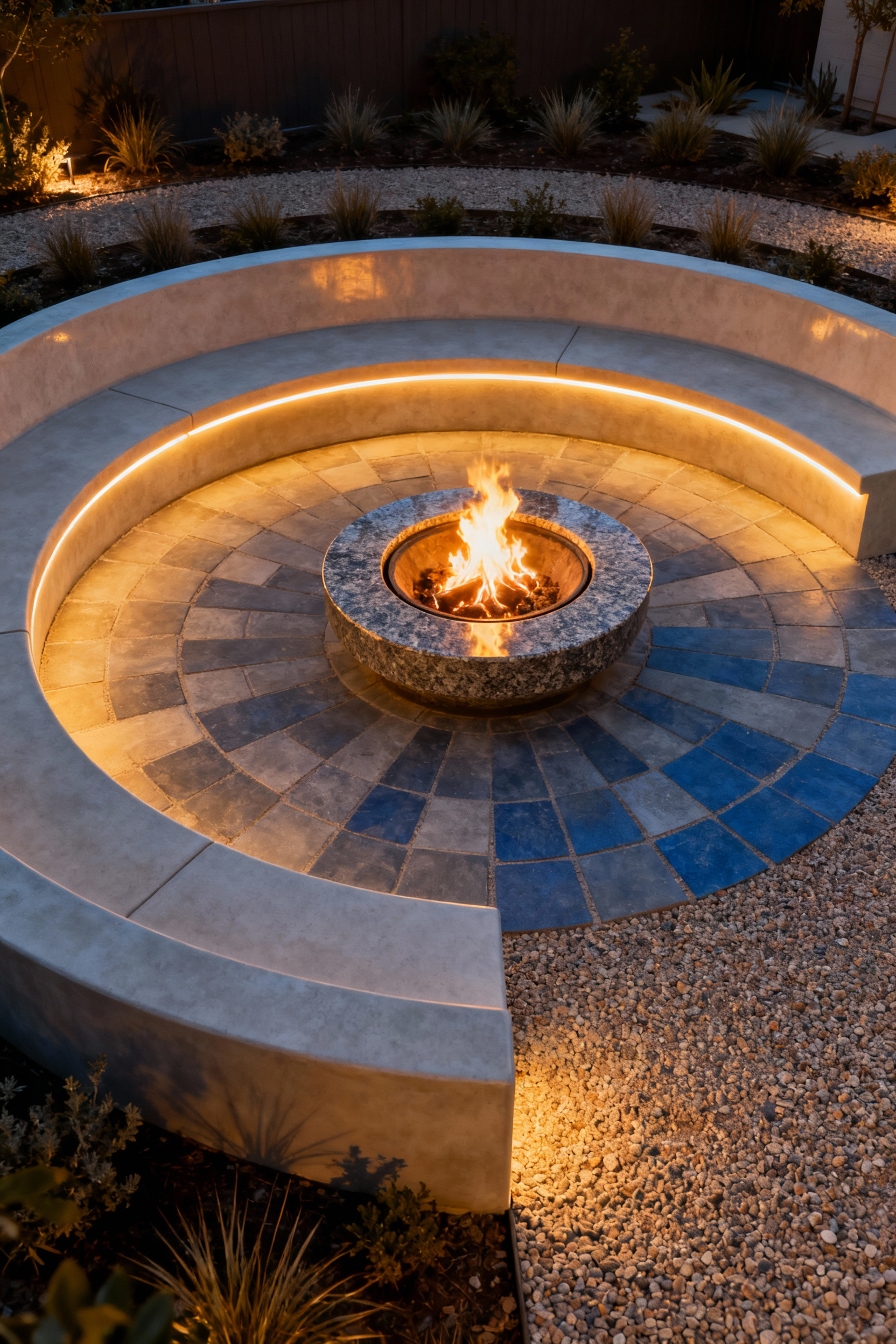
Consider a project by Sterling Design Group in the Hamptons. They crafted a grand circular firepit from honed limestone, but its brilliance was in the details of flow. The broad, low-profile perimeter of the pit itself became an impromptu surface for drinks. Curved benches were arranged to maintain visual continuity, guiding guests naturally without feeling constrained. It’s about considering how people will move to it, around it, and from it. Prioritizing this flow ensures the fire becomes a true magnet for cherished moments.
12. Ensure Seasonal Adaptability: Year-Round Multifunctional Features
A sophisticated outdoor space should transcend seasonal limits. For a firepit, this means anticipating shifts in weather and function. In the Pacific Northwest, architect Marcus Lowell designed a firepit with an integrated cantilevered cover made of marine-grade aluminum with retractable louvers. It provides shade in summer, shelter from drizzle in spring, and snow deflection in winter. By layering protection and intelligent operation, the firepit moves beyond a fair-weather amenity to become a year-round gathering point.
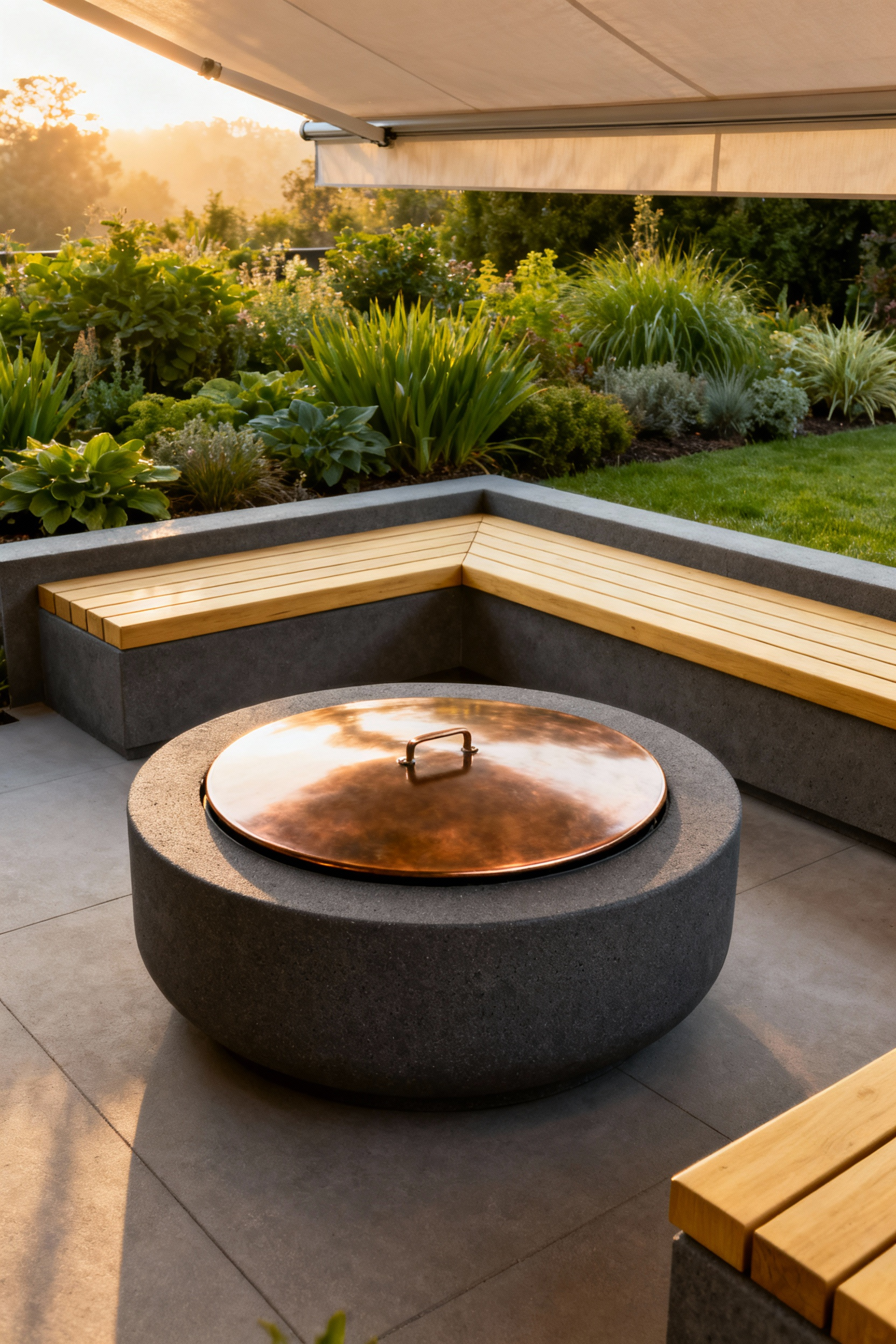
This idea of multifunctionality is where material science gets really interesting. A fire bowl can be designed to seamlessly transform into a water feature in warmer months. A protective cover, made from a durable composite, can become a usable tabletop when the fire isn’t lit. The pursuit of year-round enjoyment mandates this intelligent layering of design and material choices. It’s these adaptive features that elevate a design from merely beautiful to truly brilliant and enduring.
13. Embrace Eco-Conscious Illumination: Navigating Sustainable Fuel
As design increasingly intersects with environmental stewardship, the conversation around firepits naturally shifts toward sustainability. The romantic glow of a fire shouldn’t come at an ecological cost. I encourage clients to consider natural gas connections over propane tanks where possible, or to explore cleaner-burning bioethanol firepits that produce virtually no smoke or ash. Bioethanol is plant-derived, making it essentially carbon-neutral, and negates the need for gas lines or firewood storage.
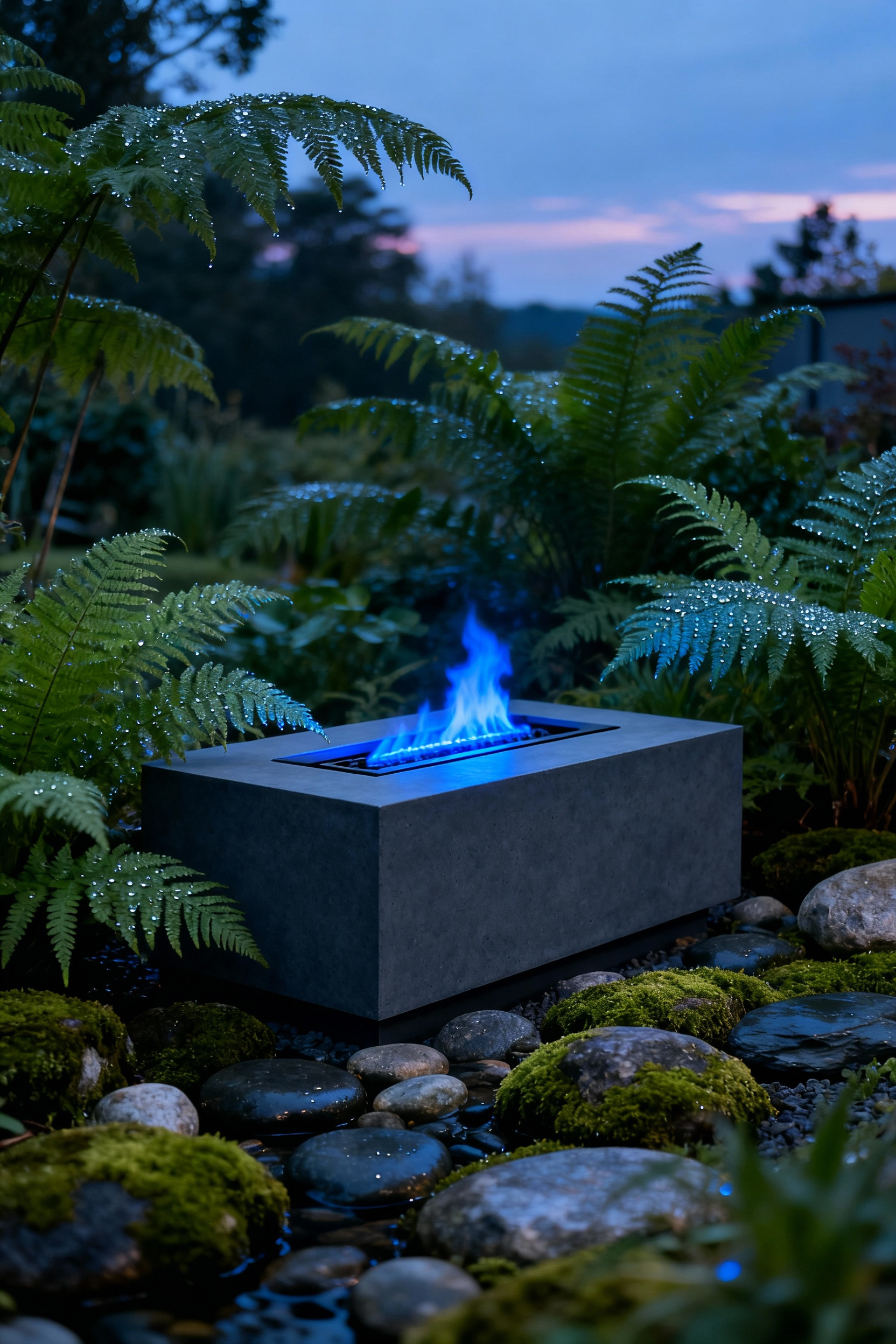
Horizon Studios used this brilliantly in a home in Boulder, Colorado. The client, an environmental advocate, wanted a sustainable option. A bioethanol fire table offered a vibrant, clean flame with zero soot. It perfectly demonstrated how aesthetic goals and green principles can coalesce. For those who love a traditional wood fire, I always advise using only seasoned, locally sourced hardwoods to ensure complete combustion and minimize particulate matter, or even opting for manufactured logs made from recycled materials. It’s about ensuring our outdoor sanctuaries offer warmth not just to our guests, but also to the planet.
14. Master Scale: Achieving Proportional Harmony with the Landscape
The most stunning firepits achieve a delicate balance, appearing neither dwarfed nor overwhelming. Mastering scale is an art. It’s about the visual weight and the dialogue between elements. As Dr. Benjamin Carver, a landscape master planner, puts it, the firepit is a “central character in a play; its size must be appropriate to its role and the stage it occupies.” A massive firepit in a tiny courtyard feels claustrophobic; a small one in a vast estate simply disappears.
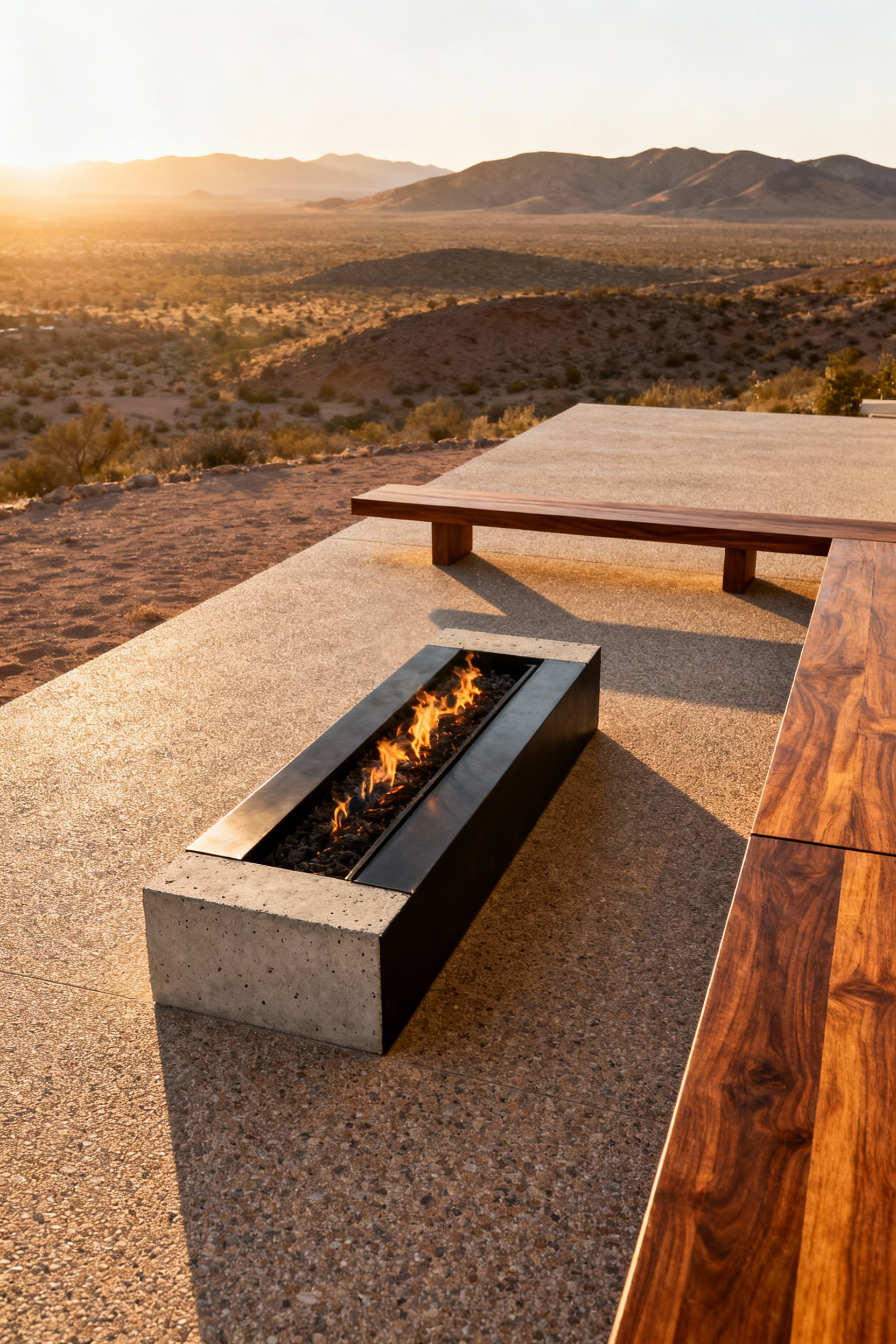
For a grand estate in Napa Valley overlooking vineyards, a standard four-foot fire bowl would have been lost. The design team instead opted for a custom-cast concrete fire table, eight feet long, with integrated perimeter seating. Its visual mass was deliberately designed to anchor the entire entertainment zone, balancing the generous pool and the distant horizon. Conversely, for a small urban patio, a precisely proportioned, elevated fire feature maximizes footprint without sacrificing impact. Achieving this harmony ensures the firepit becomes a visually cohesive and emotionally resonant centerpiece.
15. The ‘Wabi-Sabi’ Aesthetic: Embracing Natural Weathering
In a world often obsessed with perfection, there is profound beauty in embracing imperfection, transience, and the natural cycles of aging. This is the essence of Wabi-Sabi. For a firepit, this approach celebrates materials like raw concrete, local basalt, or Corten steel, allowing them to weather and evolve gracefully. This intentional aging is fundamental, allowing the feature to merge organically with the garden’s own evolving tapestry.
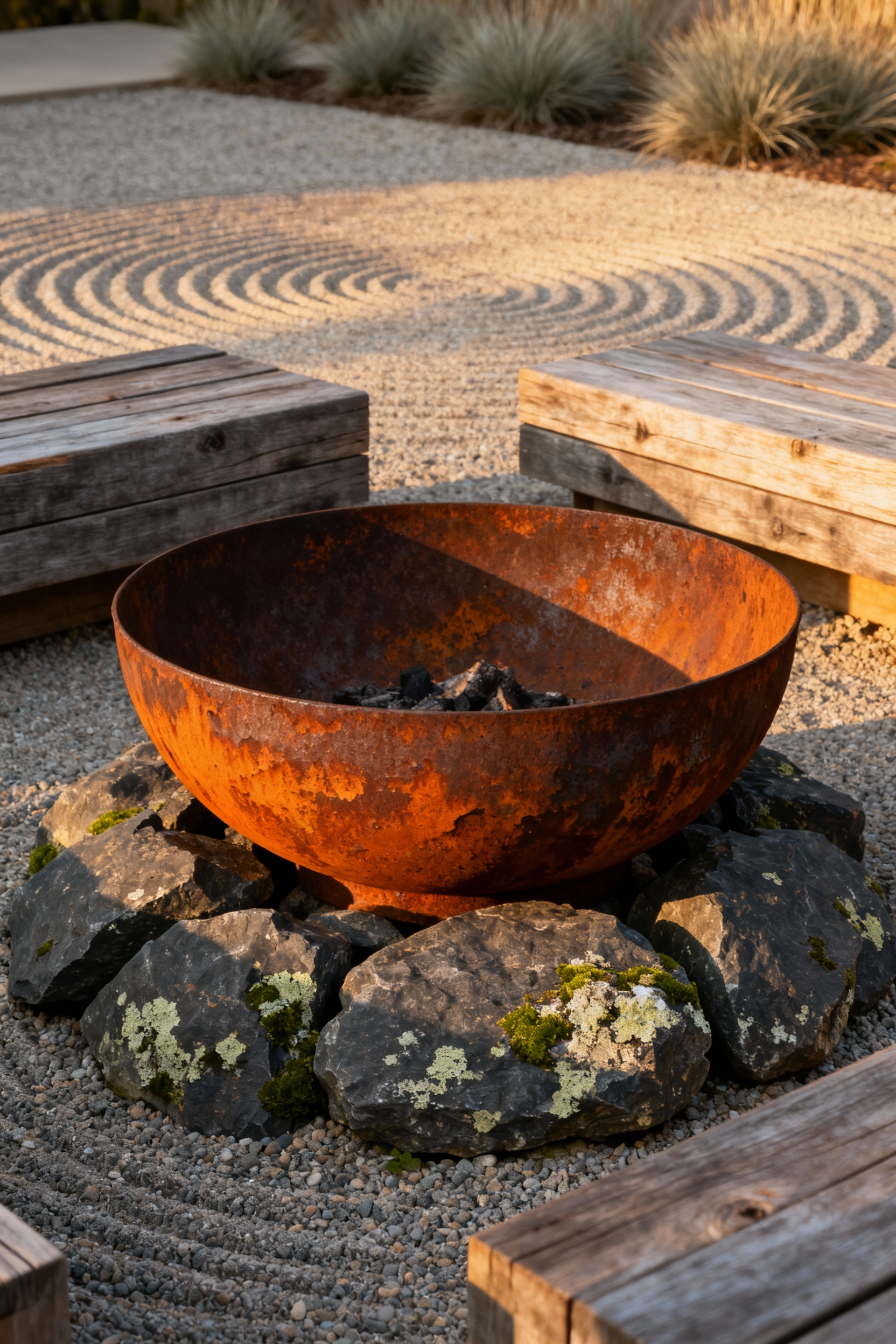
I learned this when working on a coastal project where we used reclaimed timber for the integrated benches. Initially, the client was concerned about the wood graying and showing signs of exposure. But as the seasons passed, the silvered patina of the wood began to harmonize perfectly with the shifting tones of the Corten fire bowl and the dune grasses around it. It felt more authentic, more rooted in its place. It’s about curating a landscape where the fire feature, like a cherished heirloom, grows richer and more profound each season, telling a story that perfection never could.
The Pinnacle of Bespoke Craftsmanship
Beyond standard solutions lies the realm of bespoke craftsmanship, where advanced engineering and artisanal skill converge. These are firepits designed not just to be seen, but to be experienced on a deeper level—engaging multiple senses and integrating technology so seamlessly that it feels like magic.
16. Hydronic Integration: Marrying Dynamic Water and Fire
The interplay of fire and water offers an exquisite sensory duality. This advanced principle transforms a fire feature into a dynamic focal point where the crackle of flame dances beside the serene murmur of water. My goal in design is always to curate an experience, and there is nothing quite like this. It requires precise material selection—marine-grade stainless steel or specially treated copper for water channels, positioned carefully to avoid thermal stress from the flame.

The engineering behind this is subtle but critical. Sophisticated pumps and filtration systems are needed to keep the water pristine while it flows inches from an intense fire. But the effect is transformative. Imagine a sleek trough overflowing gently with water, creating a reflective surface that doubles the perceived flame height, the water spilling silently into a lower basin. These installations don’t just occupy space; they define it, offering an oasis of dynamic serenity and visual spectacle.
17. Smart Control Systems: Automated Ignition and Advanced Safety
In an increasingly connected world, the bespoke firepit naturally integrates intelligent control. This is where luxury meets effortless function. I work to merge aesthetic appeal with cutting-edge technology, because true luxury is about ease. Clients want to ignite their firepit from their phone while walking out the door, adjust flame height remotely, and have complete confidence in its safety.
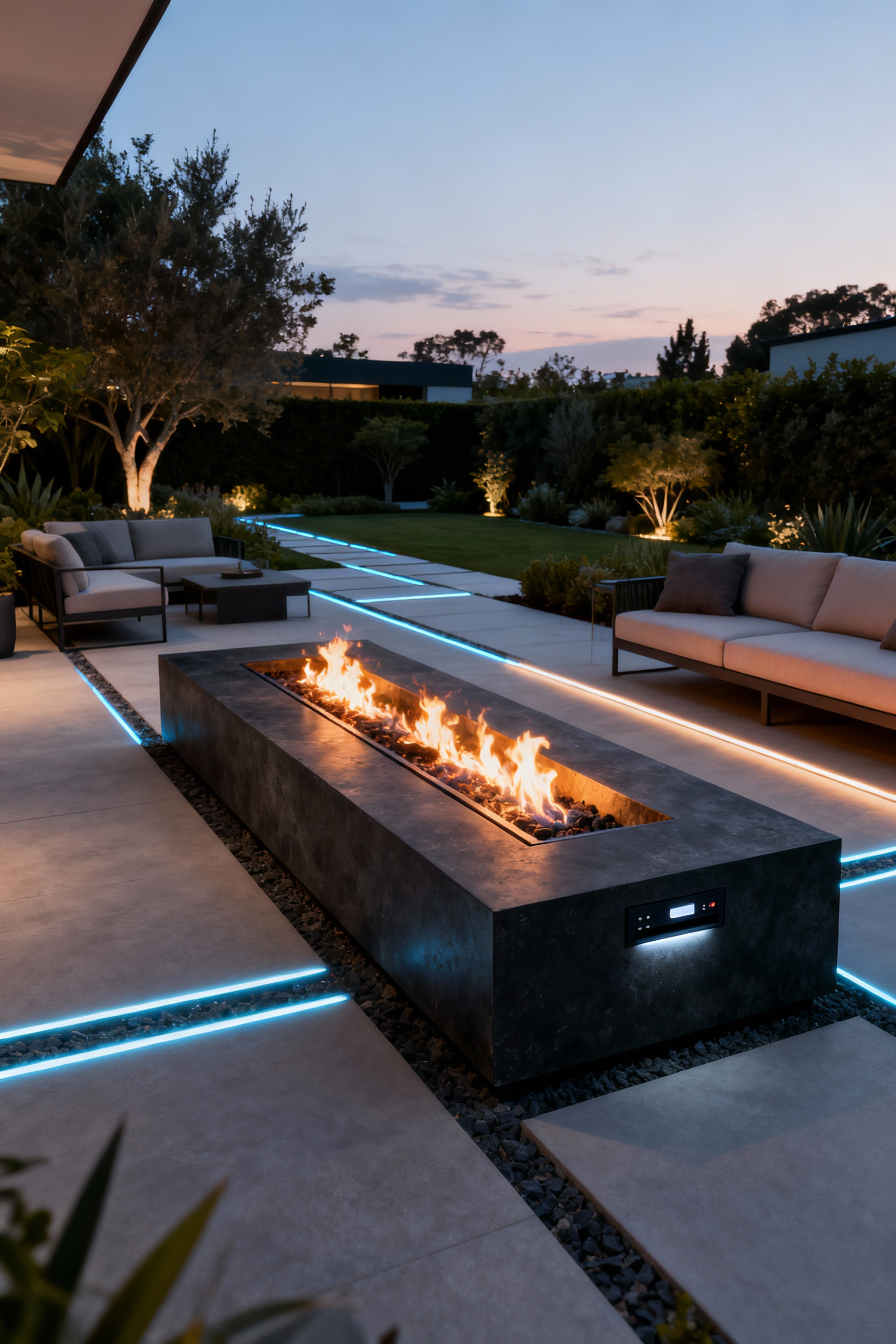
These systems go far beyond a remote control. They encompass electronic igniters, programmable timers, and environmental sensors that monitor wind speed and rain, automatically adjusting or shutting down the flame for safety. Integrated gas leak detection, tilt sensors, and flame presence confirmation are now standard. This level of advanced protocol dramatically surpasses conventional safety measures. It’s not just about controlling a fire; it’s about mastering the ambiance, ensuring every gathering is both effortless and supremely secure.
18. Perforated Metals and Light: Sculpting Evocative Shadows
Perforated metals are a masterclass in using material to sculpt light and shadow. These artful enclosures transform the raw energy of fire into a curated display of kinetic light. I love working with perforated metals because they create a dialogue between solid strength and ethereal beauty. Custom patterns—geometric, organic, or even narrative—can be laser-cut into Corten steel, stainless steel, or aluminum panels, casting intricate, ever-shifting shadow plays onto surrounding surfaces as the fire flickers.

The structural integrity of these screens must withstand significant thermal cycling, requiring alloys with excellent expansion and contraction properties. But the artistic effect is worth the engineering rigor. Imagine a firepit enclosed in a Corten steel screen with leaf-like perforations that projects a ghostly, swaying forest onto your patio at night, constantly shifting with the movement of the flames within. It turns the firepit itself into a captivating living sculpture.
19. Iterative Prototyping: The Value of Scale Models
For complex, custom projects, the leap from a 2D drawing to a 3D installation can be fraught with unforeseen challenges. This is where creating a scale model becomes invaluable. It is a critical communication tool that builds trust and clarifies vision. A high-fidelity model allows a client to see, touch, and walk around a tangible form, providing feedback on proportion and spatial dynamics in a way that a computer rendering simply cannot.
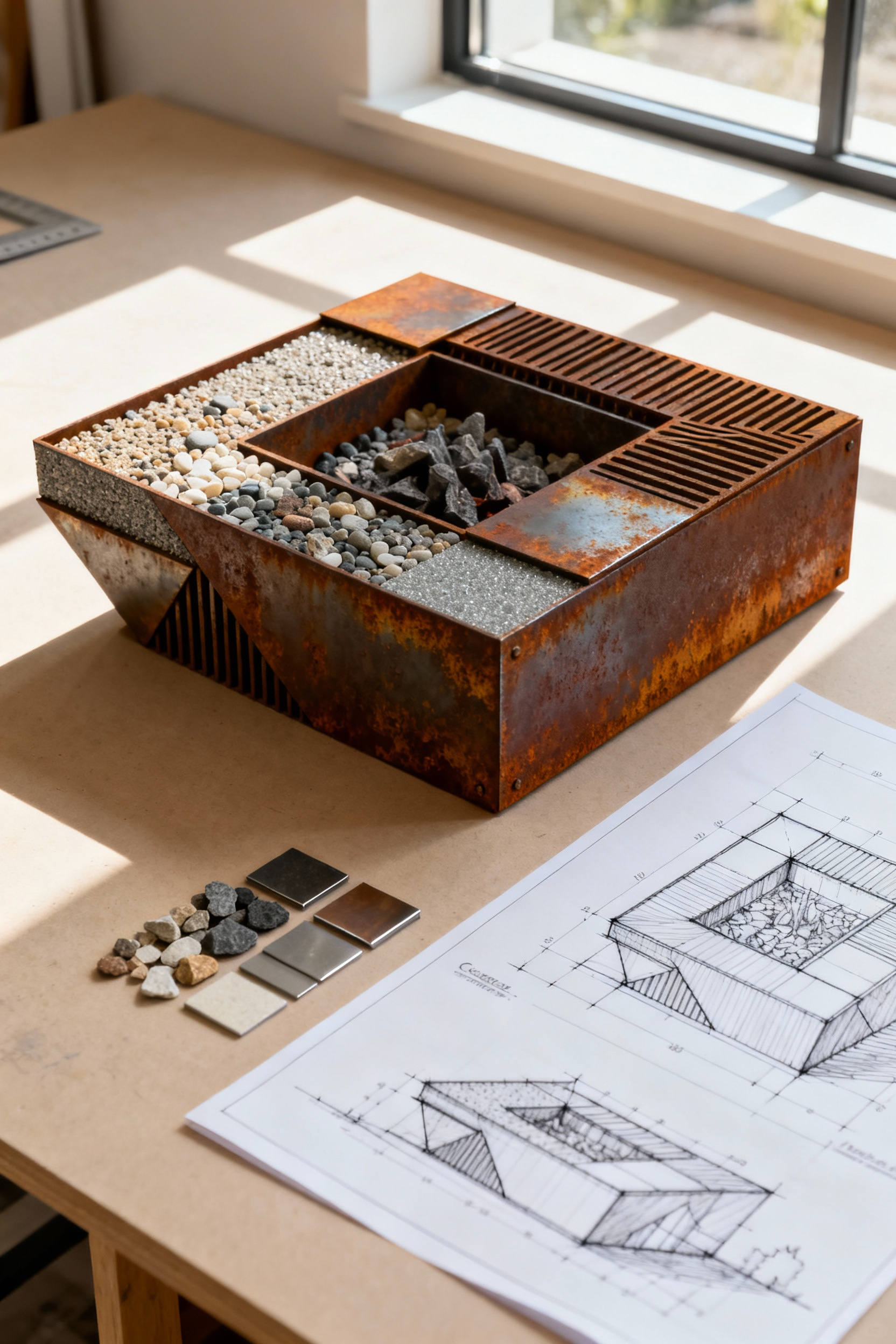
From an engineering standpoint, a model allows us to assess weight distribution, potential thermal transfer, and the integrity of unique support structures long before any expensive material is cut. We can test how water will flow for hydronic components or simulate airflow for optimal combustion. It’s a proactive measure that saves tremendous time and cost later on. This iterative process ensures every curve and every proportion is precisely as intended, transforming a concept into a tangible, perfect reality.
20. The Legacy Flame: Artisan Fabrication and Timeless Design
The ultimate aspiration is a ‘legacy flame’—a firepit that endures not just for seasons, but for generations. This requires a profound commitment to artisan fabrication and timeless design principles. Durability isn’t just about resisting wear; it’s about how a piece matures gracefully over time. This means precise welding, seamless joints, and rigorous surface treatments that ensure structural integrity against constant thermal cycling. It’s sculptural engineering.
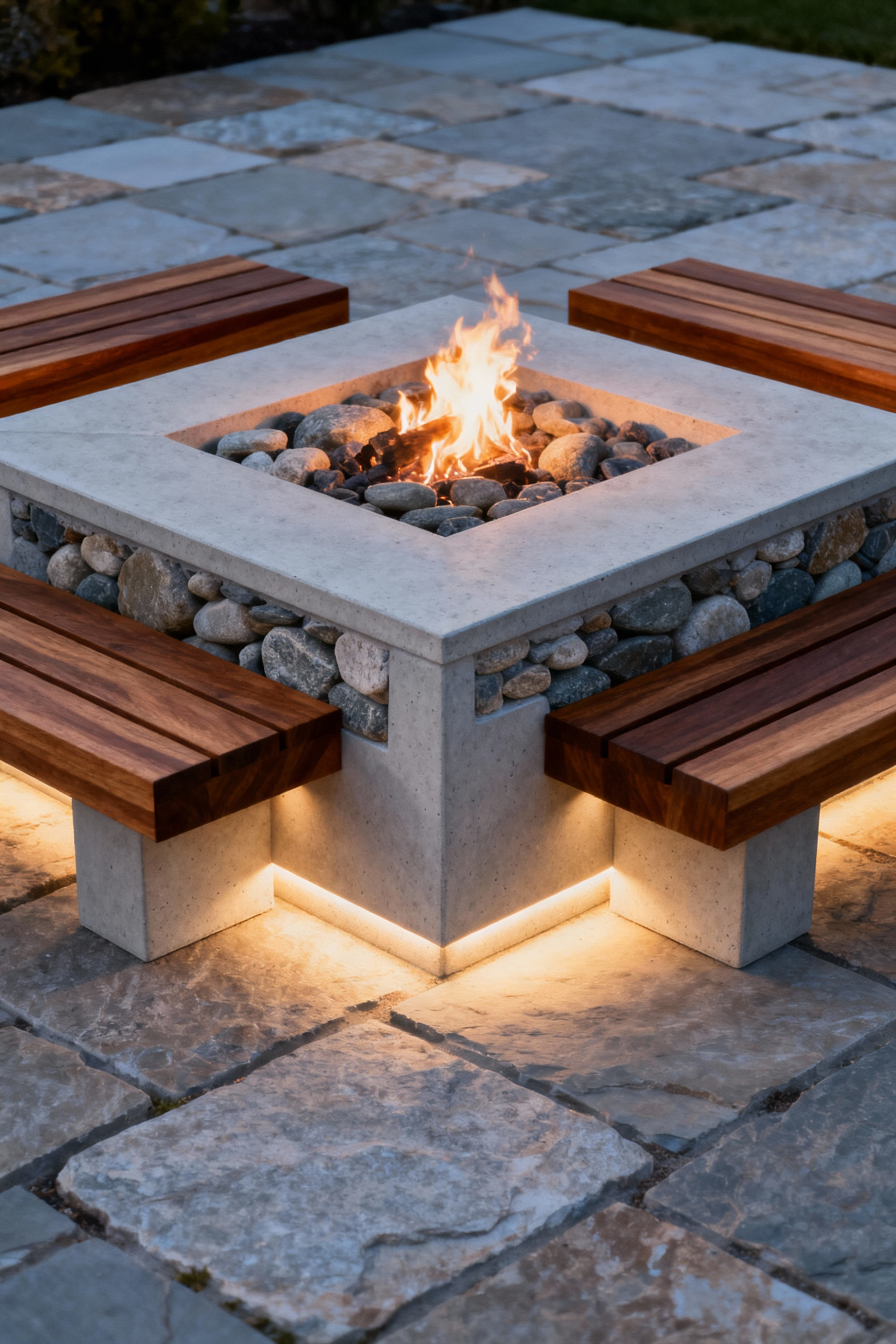
This material integrity must be paired with a design ethos of balance, proportion, and seamless integration. I always find that classic, unadorned forms allow the inherent materiality to shine, creating a focal point that feels both ancient and contemporary. By avoiding trend-driven embellishments in favor of clean lines and natural finishes, the piece transcends time. This synergy of craft and design is what creates a legacy flame—a cherished gathering point for generations to come.
Conclusion
Our exploration of these twenty transformative firepit ideas was meant to illuminate the profound potential within your own backyard. More than just a list of styles, this has been a journey into the thinking behind exceptional outdoor spaces—how strategic design, informed material selection, and precise integration can forge something truly lasting. From the living patina of Corten steel to the elemental elegance of basalt, each concept underscores a commitment to both visual impact and enduring function.
These insights are not fleeting trends, but a distillation of principles that champion longevity and sophisticated appeal. You now understand the interplay between material science and artistic vision. I invite you to take this perspective and move from aspiration to action. Use these ideas as a springboard to develop a bespoke hearth that feels like a seamless extension of your home. The goal, ultimately, is to create not just a firepit, but a timeless focal point that fosters connection and contemplation under an open sky—a true sanctuary, and a testament to the art of living well.
